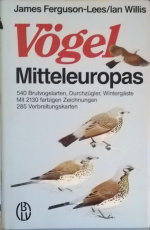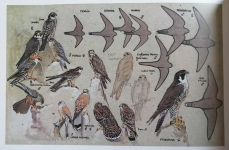Few British birders seem to be aware that there was a German version of the
Shell Guide -
Vogel Mitteleuropas - which covered 540 species (vs 488 in the orginal) and which had slightly better printed plates. Naturally, this book illustrated and described a number of non-British species. It was published four years after the
Shell Guide came out and covered most European birds (only omitting Iberian/Balkan specialites). For years I held out the hope that this meant a "European" version of the
Shell Guide might appear but, alas, this wasn't to be. Unlike the Shell Guide it didn't relegate rarities to the back of the book (but it did have the advantage that it was easier to see all the species on the front cover!).
I rather liked the illustrations in the
Fitter guide which, whatever their shortcomings, were much better than the dire distorted cartoons in
Singer & Bruun which I loathed.
Singer's warblers and pipits were, I think, particularly dreadful. Fitter et al also did a better job of tackling subspecies. I also have a particular affection for
James Fisher's
Bird Recognition as my father had a copy of Vol 1 (pub. 1947) on waders & seabirds (quite why I never discovered as, although very supportive, he was never particularly interested in birds). The monochrome illustrations in
Fisher's book weren't very useful for field ID but it packed in a lot of info about birds and was, I think, the first British bird guide to attempt to map bird distribution. (When did the American
Peterson guide get maps?). I was told that the fourth volume was never completed because the information pie charts just got too complicated for many small passerines which wouldn't be a surprise given the complexity of those that were covered)
Perhaps the greatest "what if" of bird guides is
Eric Enion's projected field guide. I've only seen the unfinished small falcons plate (see below) and whilst the lack of feather detail may not be to mordern tastes his ability to catch the essence of a species, the antithesis of
Singer's style, would have made it a remarkable book. It was well ahead of its time dating from the 1940s but it which was strangled at birth by an unsympathetic advisor to the suggested publisher. Do other designs for the plates survive? I'd love to see them.







